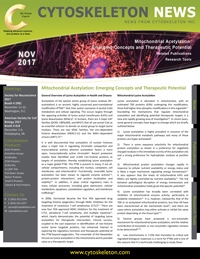November Newsletter: Mitochondrial Acetylation: Emerging Concepts and Therapeutic Potential
- By Cytoskeleton Inc. - Signal-Seeker News
- Dec 11, 2017

Acetylation of the epsilon amino group of lysine residues (Nε-acetylation) is an ancient, highly conserved post-translational modification (PTM) that links acetyl coenzyme A (acetyl-CoA) metabolism and cellular signaling. This occurs largely through the opposing activities of lysine acetyl transferases (KATs) and lysine deacetylases (KDACs). In humans, there are 3 major KAT families (GCN5, CBP/p300, and MYST) that all use acetyl-CoA as an essential cofactor to donate an acetyl group to target lysine residues. There are two KDAC families, the zinc-dependent histone deacetylases (HDAC1-11) and the NAD+-dependent sirtuins (SIRT1-7).
It is well documented that acetylation of nuclear histones plays a major role in regulating chromatin compaction and transcriptional activity wherein acetylation favors a more open, transcriptionally active chromatin. Recent proteomic studies have identified over 4,500 non-histone proteins as targets of acetylation, thereby establishing lysine acetylation as a major global PTM. This PTM is present in many, if not all, cellular compartments, including the nucleus, cytoplasm, cell membrane, and mitochondria. Functionally, reversible lysine acetylation has been shown to regulate enzyme activity, protein-protein interactions, and protein localization and stability. In addition, it plays critical regulatory roles in many cellular processes, including gene expression, cellular metabolism, apoptosis, cytoskeleton regulation, and membrane trafficking.
Also included in this newsletter:
- Signal Seeker Kits™ Kits, PTM Antibodies, Beads, and more.
- Related Publications

